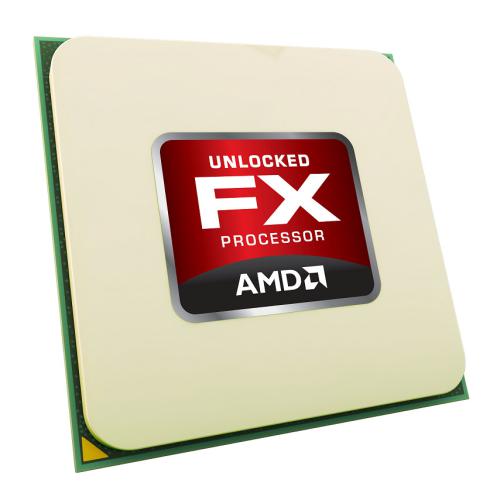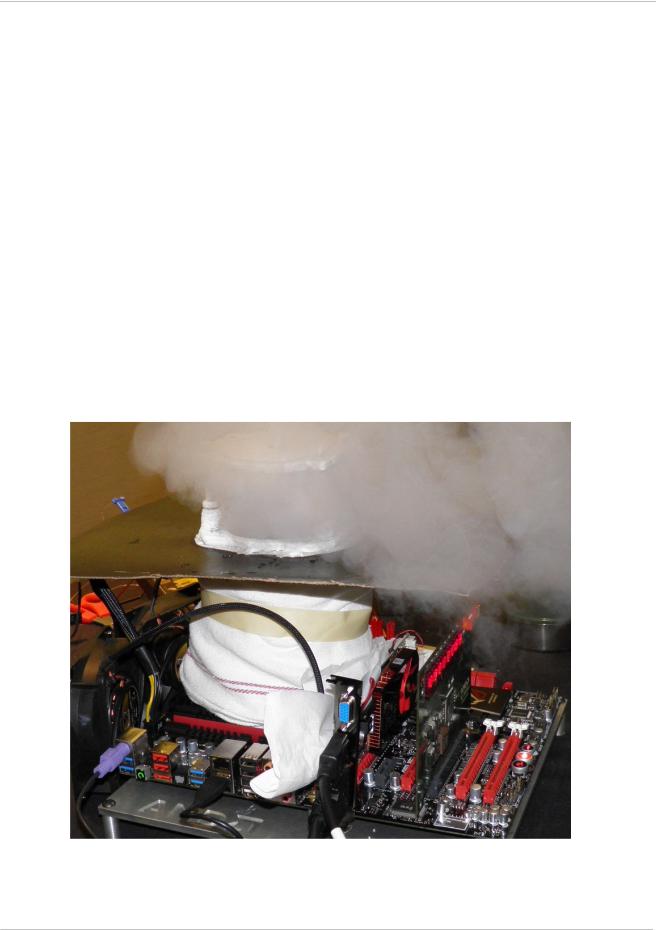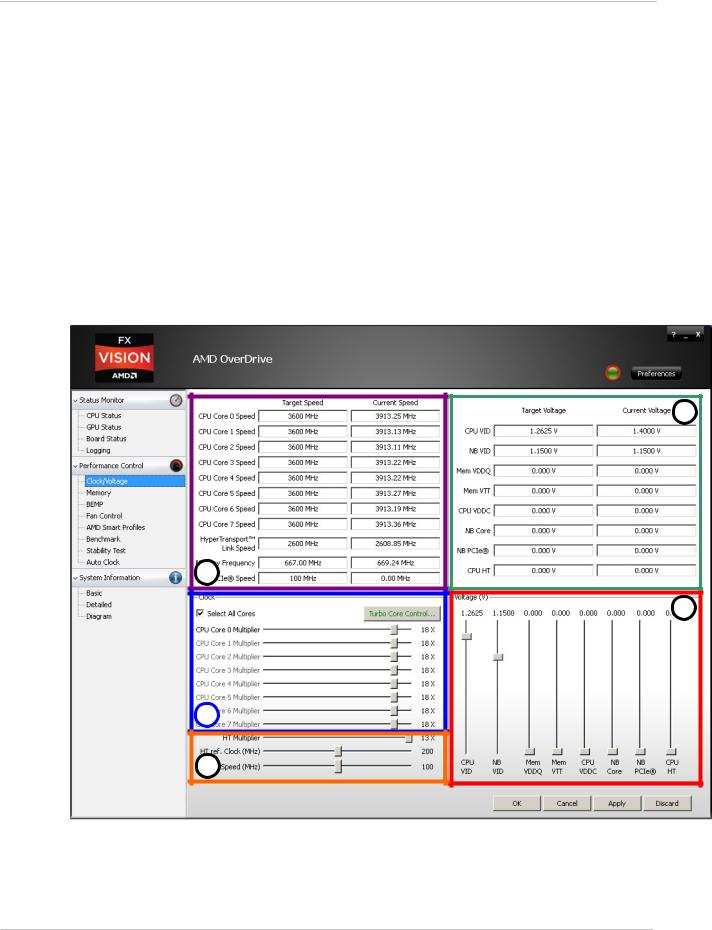AMD Fx-9370 User Manual

AMD FX Processors Unleashed | a Guide to Performance Tuning with AMD OverDrive and the new AMD FX Processors

Disclaimer
The information presented in this document is for informational purposes only and may contain technical inaccuracies, omissions and typographical errors.
The information contained herein is subject to change and may be rendered inaccurate for many reasons, including but not limited to product and roadmap changes, component and motherboard version changes, new model and/or product releases, product differences between differing manufacturers, software changes, BIOS flashes, firmware upgrades, or the like. AMD assumes no obligation to update or otherwise correct or revise this information. However, AMD reserves the right to revise this information and to make changes from time to time to the content hereof without obligation of AMD to notify any person of such revisions or changes.
AMD MAKES NO REPRESENTATIONS OR WARRANTIES WITH RESPECT TO THE CONTENTS HEREOF AND ASSUMES NO RESPONSIBILITY FOR ANY INACCURACIES, ERRORS OR OMISSIONS THAT MAY APPEAR IN THIS INFORMATION.
AMD SPECIFICALLY DISCLAIMS ANY IMPLIED WARRANTIES OF MERCHANTABILITY OR FITNESS FOR ANY PARTICULAR PURPOSE. IN NO EVENT WILL AMD BE LIABLE TO ANY PERSON FOR ANY DIRECT, INDIRECT, SPECIAL OR OTHER CONSEQUENTIAL DAMAGES ARISING FROM THE USE OF ANY INFORMATION CONTAINED HEREIN, EVEN IF AMD IS EXPRESSLY ADVISED OF THE POSSIBILITY OF SUCH DAMAGES.
WARNING: AMD processors are intended to be operated only within their associated specifications and factory settings. Operating your AMD processor outside of official AMD specifications or outside of factory settings, including but not limited to the conducting of overclocking (including use of any overclocking guide or software, even if such documentation or software has been directly or indirectly provided by AMD or otherwise affiliated in any way with AMD), may damage your processor and/or lead to other problems, including but not limited to, damage to your system components (including your motherboard and components thereon (e.g. memory)); system instabilities (e.g. data loss and corrupted images); reduction in system performance; shortened processor, system component and/or system life; and in extreme cases, total unrecoverable system failure. AMD does not provide support or service for issues or damages related to use of an AMD processor outside of official AMD specifications or outside of factory settings. You may also not receive support or service from your board or system manufacturer. Please make sure you have saved all important data before using this overclocking software. DAMAGES CAUSED BY USE OF YOUR AMD PROCESSOR OUTSIDE OF
OFFICIAL AMD SPECIFICATIONS OR OUTSIDE OF FACTORY SETTINGS ARE NOT COVERED UNDER ANY AMD PRODUCT WARRANTY AND MAY NOT BE COVERED BY YOUR BOARD OR SYSTEM MANUFACTURER’S WARRANTY. SEE THE AMD OVERDRIVE UTILITY END USER LICENSE AGREEMENT OR THE APPLICABLE AMD OVERCLOCKING UTILITY FOR DETAILS.
Use of this documentation is subject to the terms and conditions of the AMD OverDrive™ utility End User License Agreement. If you have not agreed to the End User License Agreement you do not have permission to use this guide or the AMD OverDrive™ software.
 2
2

Introduction
Systems based on the platform technology codenamed “Scorpius” may be tuned to deliver added system performance. The AMD FX™ CPUs and the AMD 9-series chipset motherboards offer an exciting amount of performance tuning options, including potential overclocking headroom. Note that each processor and chipset is different, and may result in lower or no overclocking margin.
The critically acclaimed AMD OverDrive™ utility giv es users advanced control of system performance. This utility can be used to fine tune your performance settings in real time with easy-to-use screens designed for novice to expert users. More details on how to use the AMD OverDrive utility are included in the “AMD OverDrive utility” section of this guide.
The purpose of this document is to provide detailed information on the various performance tuning knobs that are present in systems based on the AMD “Scorpius” platform technology. The guide will also offer various suggestions, “tips & tricks” and a comprehensive list of target clock speeds.
The combination of AMD “Scorpius” platform technology, AMD OverDrive utility and optimal, fine tuned settings can be used to enable truly impressive performance tuning results!
“AMD Scorpius” AM3 platform with aggressive cooling solution has achieved record breaking results.
 3
3

Glossary of Terms
HyperTransport™ Reference Clock (HT ref. clk) : The base clock for various clock domains on the AMD “Scorpius” platform technology. HT ref. clock is 200MHz by default. CPU, CPU NB, HT Link and Memory clocks are all linked to HT ref. clock. HT ref. clock adjustment is a good tool for fine tuning the various clocks to optimal values. The HT ref. clock value itself doesn’t have any impact on performance.
CPU: Central Processing Unit – the engine of the AMD “Scorpius” platform technology. CPU core clock frequency has the biggest impact on overall performance of the system. It’s the primary target of tuning.
CPU NB: CPU NorthBridge (should not be confused with NorthBridge chipset, such as the AMD 990FX chipset)
– part of the CPU that has its own clock domain and voltage plane. CPU NB clock frequency determines the Memory controller and L3 cache speed. CPU NB has a notable impact on overall system performance.
CPU FID: CPU Core Clock multiplier. In the case of the FX-8150 CPU, the default, base-level CPU multiplier is x18 (18x200MHz = 3600MHz). CPU Multiplier can be adjusted on the fly with AMD OverDrive™ utility in st eps of 0.5x. CPU Multiplier is unlocked on all of the AMD FX-series CPUs.
CPU NB FID: CPU NB Clock Multiplier. Determines the CPU NB frequency. In the case of the AMD FX-8150 CPU, the default value is x11 (11x200MHz = 2200MHz). CPU NB Multiplier adjustment requires a reboot (it can not be adjusted on the fly). Can be adjusted in steps of x1. Note that CPU NB clock should be 2x Memory clock or higher (e.g. DDR3-2400 (1200MHz) would require at least 2400MHz CPU NB clock). CPU NB Multiplier is unlocked on all of the AMD FX-series CPUs.
HT Link Multiplier: This multiplier determines the clock speed of the HT Link. In the case of the AMD FX-8150 CPU, the default value is x13 (13x200MHz = 2600MHz). In most cases a reboot is required for HT Link Multiplier value adjustment. The maximum value of HT Link Multiplier is x13. HT Link Multiplier is unlocked on all of the AMD FX-series CPUs.
CPU VID: CPU Voltage Identification Digital – a register value that programs the motherboard voltage regulator (VR) to a specific value. In short, the CPU VID determines the CPU Core Voltage level. In the case of the AMD FX-8150BE CPU, the default CPU base clock VID is usually from 1.250V to 1.350V. The Maximum CPU VID value is 1.550V. NOTE: VID value may not always equal to the actual voltage level (see “Voltage OFFSET”). VID value can be adjusted on the fly with AMD OverDrive utility.
CPU NB VID: CPU Voltage Identification Digital – a register value that programs the motherboard voltage regulator (VR) to a specific value. In short, the CPU NB VID determines the CPU NB Core Voltage level. In the case of the AMD FX-8150BE CPU the default CPU NB VID is usually 1.100V. The Maximum CPU NB VID value is 1.550V. NOTE: VID value may not always equal to the actual voltage level (see “Voltage OFFSET”). VID value can be adjusted on the fly with the AMD OverDrive™ utility.
 4
4

Glossary of Terms – continued
CPU / CPU NB Voltage OFFSET: Most AMD “Scorpius” platform technology motherboards have a BIOS option that allows Voltage adjustments beyond the CPU VID Voltage range. This voltage offset is added on top of the VID value. Voltage offset could be negative or positive. Actual voltage level = CPU or CPU NB VID + OFFSET.
Example: VID 1.350V + 0.100V OFFSET = 1.450V actual voltage level.
One of the following options will be available in the BIOS menu (depending on motherboard model):
∙“CPU Voltage” and “CPU NB Voltage” item that inclu des both VID and OFFSET values merged into one voltage adjustment item (the range can go to over 2.0V)
∙Separate items for CPU VID and CPU Voltage – here the “CPU Voltage” value starts from the VID value and then adds Offset on top of the VID
∙CPU and CPU NB “OFFSET” items that control the amount of Voltage offset
In all cases the voltage level can be tuned on the fly with AMD OverDrive utility (VID sliders). Please monitor the actual voltage level via the Hardware Monitoring.
CPU / CPU NB Voltage OVERRIDE: Some AMD “Scorpius” platform technology motherboards (such as the ASUS Crosshair 5) have a BIOS option that allows the motherboard to override the CPU VID value requested by the CPU by directly programming the voltage regulator. In this case the CPU Core Voltage and/or CPU NB Voltage will remain at a fixed voltage level. The motherboard BIOS may call this option as “manual voltage mode”. VID Override (or VID Bypass) may allow voltage levels that exceed the range of CPU VID values. In the case of AMD FX-8150 the VID range enables voltages of up to 1.550V – VID OVERRIDE may allow over 2.0V.
Note: If VID OVERRIDE / Bypass has been activated the CPU VID value adjustments via AMD OverDrive (or other software) will no longer have any impact on the actual voltage level. The only way to adjust the voltage is by directly programming the voltage regulator. The motherboard vendor may provide a software for this purpose.
AMD Turbo Core Technology: AMD Turbo Core Technology and Application Power Management (APM) allow the CPU cores to run above the CPU Base clock value as long as the CPU remains within the thermal and power limits. As an example the AMD FX-8150 CPU has a base clock of 3600MHz but it can run at 3900MHz when up to 8 cores are active and at 4200MHz when up to 4 cores are active assuming it stays within the power and thermal limits. Under very heavy workloads the CPU will return to the base clock – 3600MHz in the case of AMD FX-8150 CPU.
Since APM sets a predefined TDP limit it is usually recommended to disable both AMD Turbo Core Technology and APM features when increasing the CPU frequency and voltage above the default levels. The AMD Turbo Core Technology and APM can be disabled via AMD OverDrive utility or from the motherboard BIOS menu.
 5
5

AMD OverDrive™ utility
The AMD OverDrive™ utility is a comprehensive utili ty for performance tuning, system monitoring and testing. PLEASE NOTE THAT THE AMD PRODUCT WARRANTY DOES
NOT COVER DAMAGES CAUSED BY RUNNING COMPONENTS OUTSIDE OF SPECIFICATION.
Download from AMD Game! Website - http://sites.amd.com/us/game/downloads/amd-overdrive/Pages/overview.aspx
Advanced Mode
The AMD OverDrive utility is a powerful tool with numerous features and options. However, in this section we have limited our discussion to only cover the Advanced User mode. The Advanced User mode of the AMD OverDrive utility allows full control over all the performance settings. This includes various clock frequency adjustments, clock multiplier settings, voltage tuning and memory timings.
4
1
5
2
3
Figure 1: Screenshot from AMD OverDrive utility.
* AMD is not responsible for damages caused by overclocking (even when overclocking is enabled with AMD OverDrive™ Software). See disclaimer on page two (2) for more information.
 6
6
